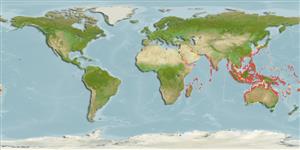Bivalvia |
Cardiida |
Psammobiidae
Environment: milieu / climate zone / depth range / distribution range
Ecology
Benthic; freshwater; brackish; pH range: ? - 15.0; depth range 0 - 30 m (Ref. 348). Tropical
Indo-West Pacific: from East Africa, to the Philippines; north to Japan and south to northern Queensland.
Length at first maturity / Size / Weight / Age
Maturity: Lm ?, range 4 - ? cm Max length : 7.0 cm SHL male/unsexed; (Ref. 348); common length : 5.5 cm SHL male/unsexed; (Ref. 348)
Occurs in extensive beds at intertidal and shallow subtidal levels, often in bays and near mangroves. Shell form varies considerably with growth (Ref. 348).
Life cycle and mating behavior
Maturity | Reproduction | Spawning | Eggs | Fecundity | Larvae
Hermaphoditism occurs in some species. Breeding is continuous throughout the year (Ref. 107755). Major and minor spawning peak occurs between December-January and May to June, respectively (Ref. 82297).
Poutiers, J.M. 1998 Bivalves. Acephala, Lamellibranchia, Pelecypoda. p. 123-362. In Carpenter, K. E. and V. H. Niem. 1998. FAO species identification guide for fishery purposes. The living marine resources of the Western Central Pacific. Volume 1. Seaweeds, corals, bivalves, and gastropods. Rome, FAO. (Ref. 348)
IUCN Red List Status
(Ref. 130435: Version 2025-1)
CITES status (Ref. 108899)
Not Evaluated
Not Evaluated
Threat to humans
Harmless
Human uses
| FishSource |
Tools
More information
Trophic EcologyFood items (preys)
Diet composition
Food consumption
Predators
PhysiologyOxygen consumption
Human RelatedStamps, coins, misc.
Internet sources
Estimates based on models
Preferred temperature
(Ref.
115969): 24.7 - 29.3, mean 28.5 (based on 3281 cells).
Resilience
High, minimum population doubling time less than 15 months (K=0.65-1).
Fishing Vulnerability
Low vulnerability (10 of 100).
Price category
Unknown.
